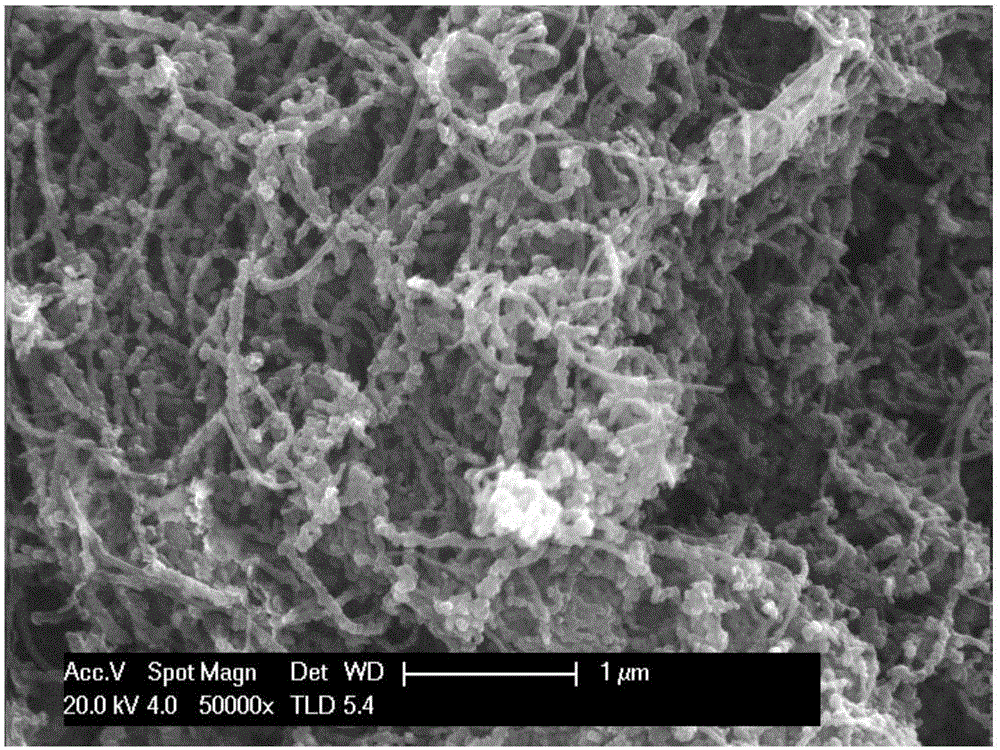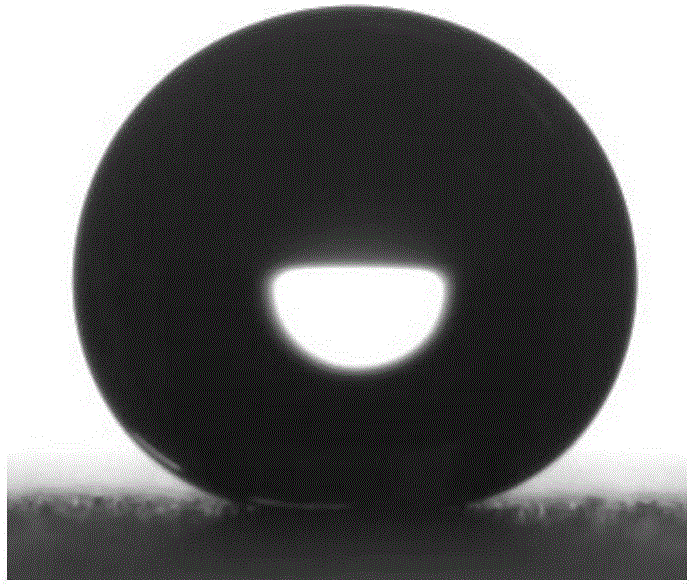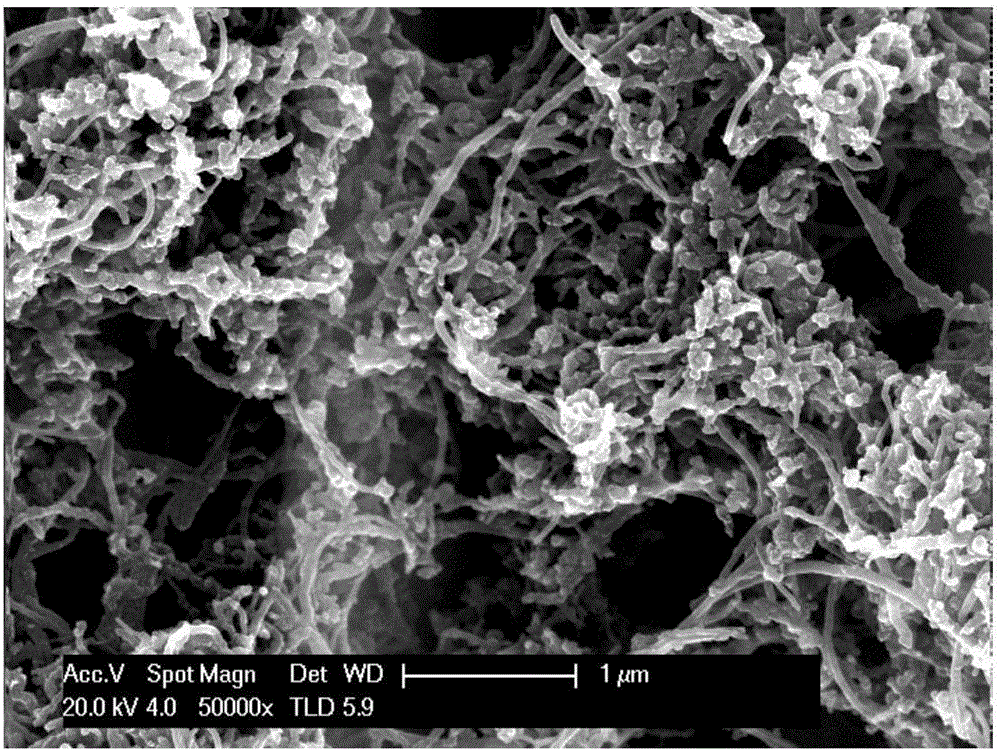Preparation method for carbon nanotube super-hydrophobic coating
A technology of super-hydrophobic coating and carbon nanotubes, which is applied in coatings, conductive coatings, etc., can solve the problems of difficult large-scale preparation, cumbersome preparation process, and harsh conditions, so as to avoid agglomeration, simple process, and keep the surface dry Effect
- Summary
- Abstract
- Description
- Claims
- Application Information
AI Technical Summary
Problems solved by technology
Method used
Image
Examples
example 1
[0020] Example 1: Preparation of carbon nanotube superhydrophobic coating by glass substrate substrate spraying method
[0021] Add 80 parts of absolute ethanol, 1 part of ammonia water, 4 parts of deionized water, and 0.8 parts of multi-walled carbon nanotubes into the beaker in a water bath at 35°C. The inner diameter of the nanotubes is 40-50 nm, the length is 10-30 μm, and the hydroxyl content is 5.58%, ultrasonically disperse for 0.5h, add 0.5 parts of tetraethyl orthosilicate dropwise to the solution, react for 1h; finally add 1 part of fluorosilane dropwise into the solution, stir for 24h to obtain a super-hydrophobic coating solution, and The solution was sprayed on the cleaned glass substrate and dried at room temperature to obtain a superhydrophobic coating of carbon nanotubes. The surface morphology was as follows: figure 1 As shown, the static contact angle of a water droplet on it is as figure 2 As shown, the contact angle is 160.3°.
example 2
[0022] Example 2: Preparation of carbon nanotube superhydrophobic coating by spin coating on copper substrate
[0023] Add 130 parts of absolute ethanol, 2.5 parts of ammonia water, 6 parts of deionized water, and 1 part of multi-walled carbon nanotubes into a beaker under the condition of a water bath at 30°C. The inner diameter of the nanotubes is 2-5 nm, the length is 10-30 μm, and the hydroxyl content is 5%, ultrasonically disperse for 1 hour, add 0.8 parts of tetraethyl orthosilicate dropwise to the solution, and react for 1.2 hours; finally, add 1 part of fluorosilane dropwise to the solution, and stir for 36 hours to obtain a superhydrophobic coating solution. The solution was spin-coated on the cleaned copper substrate, and dried at room temperature to obtain a superhydrophobic coating of carbon nanotubes. The surface morphology was as follows: image 3 As shown, condensation condensation self-bounces as Figure 4 As shown, although the carbon nanotubes can be directl...
example 3
[0024] Example 3: Preparation of carbon nanotube superhydrophobic coating by dipping micro-array silicon substrate
[0025] Add 160 parts of absolute ethanol, 4 parts of ammonia water, 7 parts of deionized water, and 1.5 parts of multi-walled carbon nanotubes into the beaker under the condition of a water bath at 45°C. The inner diameter of the nanotubes is 2-5 nm, the length is 1-3 μm, and the hydroxyl content is 8%, ultrasonically disperse for 1 hour, add 1.2 parts of tetraethyl orthosilicate dropwise to the solution, and react for 1.5 hours; finally, add 1.5 parts of fluorosilane dropwise to the solution, and stir for 58 hours to obtain a superhydrophobic coating solution. Dip the cleaned micron silicon column substrate into the solution, take it out and blow dry, repeat 3 to 5 times, and dry at room temperature to obtain a carbon nanotube superhydrophobic coating. The static contact of water droplets on it is as follows: Figure 5 As shown, the contact angle is 159.9°.
PUM
| Property | Measurement | Unit |
|---|---|---|
| The inside diameter of | aaaaa | aaaaa |
| Length | aaaaa | aaaaa |
Abstract
Description
Claims
Application Information
 Login to View More
Login to View More - R&D
- Intellectual Property
- Life Sciences
- Materials
- Tech Scout
- Unparalleled Data Quality
- Higher Quality Content
- 60% Fewer Hallucinations
Browse by: Latest US Patents, China's latest patents, Technical Efficacy Thesaurus, Application Domain, Technology Topic, Popular Technical Reports.
© 2025 PatSnap. All rights reserved.Legal|Privacy policy|Modern Slavery Act Transparency Statement|Sitemap|About US| Contact US: help@patsnap.com



